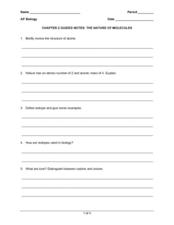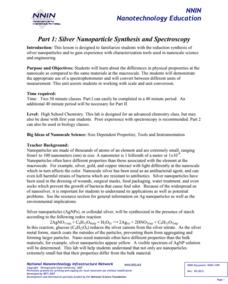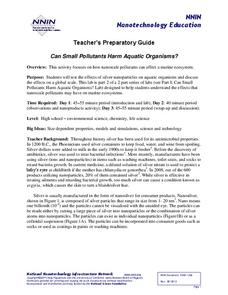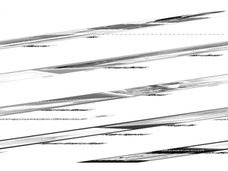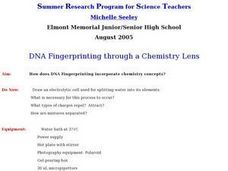Curated OER
Chemical Context of Life & Water
Some basic chemistry concepts are fundamental to understanding biology. Learners explore how molecular structure plays a role in biological processes, especially the structure of the water molecule. The final page focuses on water's...
Curated OER
Chemistry of Life Study Guide
Biology learners should understand a few chemistry basics. Here is a worksheet that introduces them to the concepts of chemical reactions, molecular bonding, and the unique combination of properties that make water vital to life....
Virginia Department of Education
Physical and Chemical Properties of Water
How can you effectively provide detailed concepts of water properties to your high school class in a way they find exciting and challenging at the same time? By letting them play, of course! Through a variety of experiments, pupils...
Curated OER
Properties of Water
Biology and chemistry learners alike will benefit from this presentation about the properties of water. It reveals that most of its unique characteristics are due to the hydrogen bonding within the water molecule. Attractive graphics...
Curated OER
The Chemistry of Life
After studying the different aspects of atoms and their reactivity, pupils will find this summary PowerPoint useful for review. Some of the slides are informative with labeled diagrams; others give important vocabulary. Teachers may want...
Curated OER
The Nature of Molecules
Even though the questions on this worksheet pertain to general chemistry, it was created for an AP biology course. It is crucial for biology learners to grasp these concepts as a foundation for biochemical processes that they will...
Biology Junction
Biochemistry of Cells
Chemistry and biology work hand in hand, without one you literally wouldn't have the other. Using a presentation, individuals learn about plant cells, animal cells, cell responses, macromolecules, DNA bases, and so much more. A worksheet...
National Nanotechnology Infrastructure Network
Silver Nanoparticle Synthesis and Spectroscopy
Certain materials do not always maintain the same physical properties when they exist in the nanoscale. Help your classes to explore this idea through an experimental lesson plan. Scholars use spectroscopy with samples of silver solution...
Curated OER
Lipids: Fats and Oils
A fantastic presentation with great images should improve student understanding of lipids and their involvement in the body. The chemistry of different fats, phospholipids, and steroids are explained. Additionally, the specific uses,...
Cornell University
Renewable Resins and Composites
Merge chemistry with environmental science to study biodegradable materials. An engaging activity allows learners to experiment with different resin concentrations and composites. Through experimental tests, scholars test their creations...
Curated OER
Science Lesson Plans
Students conduct a variety of exploration activities on various science topics. In this science lesson plan outline, students design a cell encapsulation to hold a specific type of medicine. They give examples of physical and chemical...
Curated OER
Confectionary Bureau of Investigations: Case of the Cookie Mystery
Students perform tests on different chemicals to determine their chemical properties. In this forensic science lesson, students identify an unknown sample using its physical and chemical properties. They solve a fictional crime using...
National Nanotechnology Infrastructure Network
Can Small Pollutants Harm Aquatic Organisms?
Nanoparticles have toxic effects on plant and animal life—even though you can't see them. The second lesson of a two-part series has young scientists conduct an experiment that exposes plant and animals to nanoparticle pollutants. They...
Curated OER
The Tell-Tale Plume
Students examine hydrothermal vents. In this ocean lesson, students identify changes in physical and chemical properties of sea water caused by hydrothermal vents.
Curated OER
DNA Fingerprinting through a Chemistry Lens
Students explore DNA and restriction enzymes using fragments of DNA separated by electrophoresis on an agarose gel. They analyze the results to see "whodunit".
Curated OER
Root, Root, Root for the Nutrients
Young scholars observe the growth of a seed, predict what will happen when seeds are planted without soil, and conduct an experiment using a hydroponics system.
Curated OER
Microscopes and Crystals
Students observe crystals under the microscope. In this science lesson, students compare how the crystal look like using their eyes, hand lens and microscope. They identify the type of crystal based on the amount of light they allow to...
Curated OER
The Basics of Biochemistry
Science teachers can introduce basic chemical concepts to biology students.
Curated OER
Lipid Worksheet
In this lipid learning exercise, students answer questions about the structure and functions of lipids. They read about the three main lipids in the body including triglycerides, phospholipids and cholesterol and answer questions about...
Curated OER
Growing Barley for Use in Biosynthesis Experiments
Students attempt to determine the optimum growing conditions for barley. They assess the effects of a number of substances such as ammonium chloride and urea on the plants
Curated OER
Start at the Very Beginning
Students explore ocean ecosystems. In this cross curriculum art and oceans lesson, students create a collage featuring three-finger algae using sand paper, tissue paper, and construction paper.







